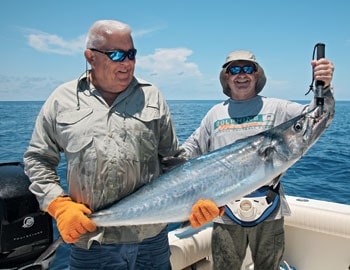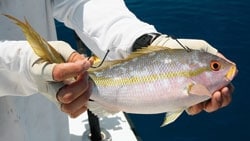
Have you ever cursed like an irate pirateover catching a 36-pound king mackerel? Well Jim Hanrahan, Bobby Brack, Keith Brack and I did exactly that in the Bahamas one day last summer. As we were yellowtailing a Bimini reef, two hefty kings darted through the chum slick. We free-lined our “king crusher” bait, and both fish charged: Unfortunately, the smaller king got there first, igniting our sea rage!
Keith Brack skillfully played out the fish from our anchored boat. We immediately iced this fish and pitched out another king crusher bait on a nearly identical outfit. It didn’t take long for the trophy king to strike, severing the bait and somehow missing the hooks. Then it circled back and consumed the head in one bite, and the fight was on. Hanrahan took the rod, and a light drag enabled the huge king to keep taking line. Fortunately, the fish stopped with a quarter of the line left on the reel. It was a long and tedious fight for Hanrahan, but when I gaffed the fish and heaved it into the cockpit, it weighed 50 pounds, 6 ounces and shifted our moods 180 degrees.
Yeah, Yeah, Yeah
Anglers seeking trophy-class king mackerel have heard countless times that using ultralight wire, tiny treble or single hooks, light drag settings and frisky live baits is a must to fool them. And there’s no denying this works, as many big kings continue to be caught in this manner on live menhaden, hardtails, goggle-eyes and even fresh ribbonfish. But to consistently score the trophies, you might consider straying from this tactic.
I’ll come clean here and admit that the biggest king mackerel taken on my boat – a 66 3/4-pound monster – was caught a couple of decades ago by Margo Vincent and Poppy Brownlee on a live goggle-eye while we were sailfishing off Florida’s Palm beaches. I’d love to claim we were targeting big kings, but we weren’t. Yet nearly every 40- and 50-pound-class king I’ve taken since has been caught intentionally and come on baits that make large goggle-eyes look like minnows! Confused? Read on.
Shake It Up, Baby!
Chumming stirs up life. Once anchored, we deploy at least one large mesh nylon bag containing a block of frozen chum. Then we supplement the slick by ladling out a mixture of thawed chum, silversides, fine-grain scratch chicken feed and just enough seawater to make this mix thick and pasty (it’s kept in a five-gallon bucket). In addition, we’ll sweeten the chum line periodically by broadcasting small chunks of Spanish sardines, pilchards or even ballyhoo.

Soon yellowtails, mackerel and schools of baitfish ranging from ballyhoo to runners take up stations in the slick. At this stage, we simply fun-fish for the snappers (some go on ice for our dinners, and some go into our livewell), Spanish macks and grouper, certain that it’s only a matter of time before a big king joins the party. This same tactic can be applied when you’re drifting over structure or within a school of Spanish mackerel, or even bonito, when they’re schooling over the reefs and structure. Don’t ever forget that the largest kings feed on Spanish mackerel and bonito.
The Gear
Since we’re at anchor and over hard bottom, line capacity and toughness become issues. Our designated live bait outfits are spooled with either 30-pound or 50-pound braid ending in a Bimini twist and joined to a 20-foot top shot of 30-pound fluorocarbon with a Bristol knot. The fluorocarbon provides a cushion against the no-stretch braid and is less visible. The Penn Torque 100 and 200 reels offer plenty of line capacity, and matched jigging rods lend an ultralight feel yet pack plenty of backbone.
The actual leader is about 2 feet of 38-pound-test single-strand wire attached to the monofilament top shot with a 120-pound-test barrel swivel. Now here’s where I depart from the tiny-hooks philosophy. Tiny hooks do catch a lot of fish, but many fish are lost when these diminutive hooks pull out or straighten. Furthermore, small hooks make it tougher to release kings. These hooks often lodge deep in the throat, and the light drag required to prevent pulling or straightening them plays big fish to exhaustion.

I’ve developed a system in which once a king is hooked, I don’t have to worry about pulling or straightening a hook. I can apply enough pressure to end the fight quickly, while the fish is still in good shape. What’s more, rarely will the fish be hooked deeply. I use circle hooks for both the lead and the stinger hooks. My lead hook, based on the size of the bait, is either a 7/0 or 8/0, in-line, and my stinger is the same model in a 6/0 or 7/0. The stinger hook is joined to 4 or 5 inches of 38-pound-test single-strand wire and a 120-pound-test barrel swivel. When fabricating this rig, lay the eye of the barrel swivel on the stinger wire over the eye of the lead hook so the main wire leader must past through both hook eyes before the haywire twist/barrel wrap is completed. That’s all there is to the rig, outside of adjusting the length of the stinger wire to match the chosen bait.
The King Cut
The next part of the equation is big baits. Kings are “slashers,” meaning they sever and consume one portion of a sizable prey on the strike and then swing back around for the remains. In this approach, we choose a legal-size yellowtail or a cero or Spanish mackerel over a bite-size bait. Some of our baits would look good on dinner plates. I’ve fished many a goggle-eye, blue runner, live ballyhoo, horse pilchard, threadfin herring and speedo for big kings, but none have elicited the consistent results of big yellowtails and cero and Spanish mackerel.

Prior to live-lining a bait, I’ll strip off line up to the Bristol knot that joins the braid to the fluorocarbon wind-on, some 20 feet up from the hook. Then I secure a balloon float to the double line or along the fluoro wind-on if I want to “shallow up” the bait. The lead circle hook is lightly embedded just in front of the bait’s dorsal fin. I prefer a stinger that is free-swinging, so I let that trailing circle hook dangle.
The bait is then free-lined well back in the chum slick, where it won’t interfere with our yellowtail fishing. I place the rod in a gunwale holder, back off the drag and engage the reel clicker so there’s just enough tension to keep the line from backlashing on the strike but not so much that the king feels the pressure.
I fish with a relatively light drag to avoid kinking and breaking the 38-pound-test wire leader. On the strike, I leave the rod in the holder and, once the king has full possession of the bait, advance the drag until one of the circle hooks sets. Then someone picks up the outfit and has fun! If a king misses on the strike and there’s still a chunk of bait left on the rig, free-spool the remains and stand ready to counter when the king circles back to pick it off.
At anchor or on the drift, we frequently add a fishing kite to the spread. With this in play, there’s one big bait swimming under a balloon float and another kicking up a ruckus at the surface. Big kings react wildly to distress vibrations. And since the back of the bait will be breaking the surface, there’s little concern over a king’s seeing the terminal hardware.
Yearning to log a bunch of trophy kings this coming season? Give our approach a try, and go bottomfishing. Stir up the reefs, wrecks, ledges or rigs, and you’ll ultimately and undoubtedly wake up a sleeping giant. Send out a meal that’s fit for a king.
The Best Kingfish Baits
| Menhaden Also known as pogies, these baits are common in large schools along the Atlantic seaboard.Little Tunny Smaller individuals of this species, aka bonito and false albacore, make great kingfish baits.Threadfin Herring These fragile baits attract just about any predator and are called greenies in South Florida.Yellowtail The yellowtail snapper is a major food source for kings (and fishermen) in the Florida Keys.Spanish Mackerel Big kings prey upon their smaller cousins, which are fished live or rigged dead with multiple hooks. | Cero Mackerel Although seldom pressed into service as bait, this king mack relative will attract strikes too. Blue Runner Known as hardtails, these hardy small jacks are arguably the most widely used bait of all.Goggle-Eye **More correctly known as bigeye scad, the goggle-eye is another South Florida favorite.Ballyhoo** These halfbeaks swim in large schools and are fished live, or drifted dead, with multiple hooks. |









